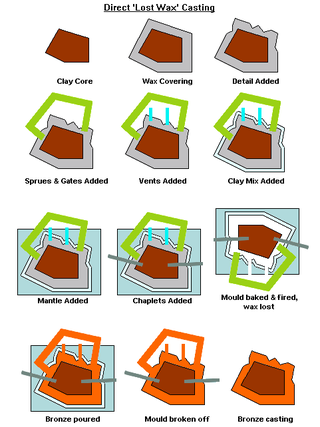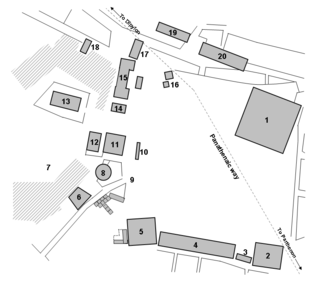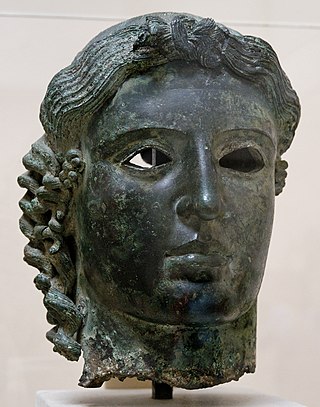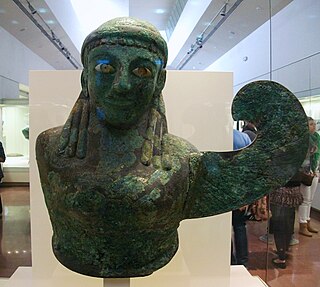
The Piraeus Apollo is an ancient Greek bronze sculpture in the archaic style from the 2nd or 1st century BC [1] (or possibly an earlier work dating 4th or 3rd century BC [2] ), exhibited now at the Archaeological Museum of Piraeus, Athens.

The Piraeus Apollo is an ancient Greek bronze sculpture in the archaic style from the 2nd or 1st century BC [1] (or possibly an earlier work dating 4th or 3rd century BC [2] ), exhibited now at the Archaeological Museum of Piraeus, Athens.

The sculpture was discovered in the ancient harbor of Piraeus in July 1959, along with the Piraeus Athena and Piraeus Artemis [3]
The Piraeus Apollo was long thought to be a product of the late archaic period (530–480 BC), and would have been among the few bronzes from that time period to have survived. Newer research view it as a archaizing (mimicking the archaic tradition) sculpture of the Hellenic period. This is due to its mixing of features from different time periods and its stance, which contrasts other archaic kouroi, such as the Kroisos Kouros, as pointed out by Olga Palagia. [1] [2]

The Charioteer of Delphi, also known as Heniokhos, is a statue surviving from Ancient Greece, and an example of ancient bronze sculpture. The life-size (1.8m) statue of a chariot driver was found in 1896 at the Sanctuary of Apollo in Delphi. It is now in the Delphi Archaeological Museum.

Lost-wax casting – also called investment casting, precision casting, or cire perdue – is the process by which a duplicate sculpture is cast from an original sculpture. Intricate works can be achieved by this method.

The sculpture of ancient Greece is the main surviving type of fine ancient Greek art as, with the exception of painted ancient Greek pottery, almost no ancient Greek painting survives. Modern scholarship identifies three major stages in monumental sculpture in bronze and stone: the Archaic, Classical (480–323) and Hellenistic. At all periods there were great numbers of Greek terracotta figurines and small sculptures in metal and other materials.

Archaic Greece was the period in Greek history lasting from c. 800 BC to the second Persian invasion of Greece in 480 BC, following the Greek Dark Ages and succeeded by the Classical period. In the archaic period, Greeks settled across the Mediterranean and the Black Seas, as far as Marseille in the west and Trapezus (Trebizond) in the east; and by the end of the archaic period, they were part of a trade network that spanned the entire Mediterranean.

Classical sculpture refers generally to sculpture from Ancient Greece and Ancient Rome, as well as the Hellenized and Romanized civilizations under their rule or influence, from about 500 BC to around 200 AD. It may also refer more precisely a period within Ancient Greek sculpture from around 500 BC to the onset of the Hellenistic style around 323 BC, in this case usually given a capital "C". The term "classical" is also widely used for a stylistic tendency in later sculpture, not restricted to works in a Neoclassical or classical style.

Stoa Basileios, meaning Royal Stoa, was a Doric stoa in the northwestern corner of the Athenian Agora, which was built in the 6th century BC, substantially altered in the 5th century BC, and then carefully preserved until the mid-second century AD. It is among the smallest known Greek stoas, but had great symbolic significance as the seat of the Athenian King Archon, repository of Athens' laws, and site of "the stone" on which incoming magistrates swore their oath of office.

Dreros, also Driros, near Neapoli in the regional unit of Lasithi, Crete, is a post-Minoan archaeological site, 16 km northwest of Agios Nikolaos. Known only by a chance remark of the 9th-century Byzantine grammarian Theognostus, archaeology of the site shows Dreros to have been initially colonised by mainland Greeks in the early Archaic Period about the same time as Lato and Prinias.

The Antikythera Ephebe, registered as: Bronze statue of a youth in the museum collections, is a bronze statue of a young man of languorous grace that was found in 1900 by sponge-divers in the area of the ancient Antikythera shipwreck off the island of Antikythera, Greece. It was the first of the series of Greek bronze sculptures that the Aegean and Mediterranean yielded up in the twentieth century which have fundamentally altered the modern view of ancient Greek sculpture. The wreck site, which is dated about 70–60 BC, also yielded the Antikythera mechanism, a characterful head of a Stoic philosopher, and a hoard of coins. The coins included a disproportionate quantity of Pergamene cistophoric tetradrachms and Ephesian coins, leading scholars to surmise that it had begun its journey on the Ionian coast, perhaps at Ephesus; none of its recovered cargo has been identified as from mainland Greece.

The Artemision Bronze is an ancient Greek sculpture that was recovered from the sea off Cape Artemision, in northern Euboea, Greece. According to most scholars, the bronze represents Zeus, the thunder-god and king of gods, though it has also been suggested it might represent Poseidon. The statue is slightly over lifesize at 2.09 meters, and would have held either a thunderbolt, if Zeus, or a trident if Poseidon. The empty eye-sockets were originally inset, probably with bone, as well as the eyebrows, the lips, and the nipples. The sculptor is unknown. The statue is a highlight of the collections in the National Archaeological Museum of Athens.

The Chatsworth Head is a slightly over-life-size bronze head dating to around 460 BCE which is now in the British Museum.
Brunilde Sismondo Ridgway is an Italian archaeologist and specialist in ancient Greek sculpture.

A sphyrelaton is a term used for a type of archaic Greek bronze votive statues of considerable size.
The Sounion Kouros is an early archaic Greek statue of a naked young man or kouros carved in marble from the island of Naxos around 600 BCE. It is one of the earliest examples that scholars have of the kouros-type which functioned as votive offerings to gods or demi-gods, and were dedicated to heroes. Found near the Temple of Poseidon at Cape Sounion, this kouros was found badly damaged and heavily weathered. It was restored to its original height of 3.05 meters (10.0 ft) returning it to its larger than life size. It is now held by the National Archaeological Museum of Athens.

The Piraeus Athena is a bronze statue dated to the fourth century BCE. It currently resides in the Archaeological Museum of Piraeus.

Piraeus Artemis refers to two bronze statues of Artemis excavated in Piraeus, Athens in 1959, along with a large theatrical mask and three pieces of marble sculptures. Two other statues were found in the buried cache as well: a larger-than-lifesize bronze Late Archaic Apollo and a similarly sized bronze fourth century-style Athena. Both statues are now exhibited in the Archaeological Museum of Piraeus in Athens.

Ancient Greek art stands out among that of other ancient cultures for its development of naturalistic but idealized depictions of the human body, in which largely nude male figures were generally the focus of innovation. The rate of stylistic development between about 750 and 300 BC was remarkable by ancient standards, and in surviving works is best seen in sculpture. There were important innovations in painting, which have to be essentially reconstructed due to the lack of original survivals of quality, other than the distinct field of painted pottery.
Olga Palagia is Professor of Classical Archaeology at the National and Kapodistrian University of Athens and is a leading expert on ancient Greek sculpture. She is known in particular for her work on sculpture in ancient Athens and has edited a number of key handbooks on Greek sculpture.
Carol C. Mattusch is the Mathay Professor of Art History at George Mason University. She is a specialist in Greek, Roman and 18th century art.

Classical Greek sculpture has long been regarded as the highest point in the development of sculptural art in Ancient Greece, becoming almost synonymous with "Greek sculpture". The Canon, a treatise on the proportions of the human body written by Polykleitos around 450 B.C., is generally considered its starting point, and its end marked with the conquest of Greece by the Macedonians in 338 B.C., when Greek art began a great diffusion to the East, from where it received influences, changed its character, and became cosmopolitan. This phase is known as the Hellenistic period. In this period, the tradition of Greek Classicism was consolidated, with Man being the new measure of the universe.

Archaic Greek Sculpture represents the first stages of the formation of a sculptural tradition that became one of the most significant in the entire history of Western Art. The Archaic period of Ancient Greece is poorly delimited, and there is great controversy among scholars on the subject. It is generally considered to begin between 700 and 650 BC and end between 500 and 480 BC, but some indicate a much earlier date for its beginning, 776 BC, the date of the first Olympiad. In this period the foundations were laid for the emergence of large-scale autonomous sculpture and monumental sculpture for the decoration of buildings. This evolution depended in its origins on the oriental and Egyptian influence, but soon acquired a peculiar and original character.